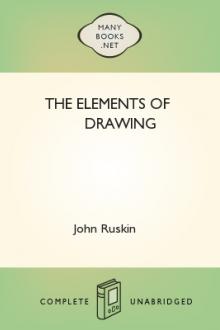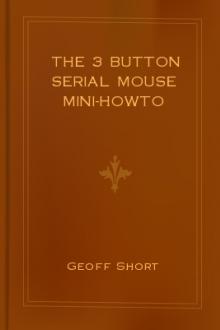The Elements of Drawing by John Ruskin (smart books to read .txt) 📕

xii. One task, however, of some difficulty, the student will find I have not imposed upon him: namely, learning the laws of perspective. It would be worth while to learn them, if he could do so easily; but without a master's help, and in the way perspective is at present explained in treatises, the difficulty is greater than the gain. For perspective is not of the slighte
Read free book «The Elements of Drawing by John Ruskin (smart books to read .txt) 📕» - read online or download for free at americanlibrarybooks.com
- Author: John Ruskin
- Performer: -
Read book online «The Elements of Drawing by John Ruskin (smart books to read .txt) 📕». Author - John Ruskin
238. You can only, however, feel your way fully to the right of the thing by working from Nature.
The best subject on which to begin a piece of study of this kind is a good thick tree trunk, seen against blue sky with some white clouds in it. Paint the clouds in true and tenderly gradated white; then give the sky a bold full blue, bringing them well out; then paint the trunk and leaves grandly dark against all, but in such glowing dark green and brown as you see they will bear. Afterwards proceed to more complicated studies, matching the colors carefully first by your old method; then deepening each color with its own tint, and being careful, above all things, to keep truth of equal change when the colors are connected with each other, as in dark and light sides of the same object. Much more aspect and sense of harmony are gained by the precision with which you observe the relation of colors in dark sides and light sides, and the influence of modifying reflections, than by mere accuracy of added depth in independent colors.
239. This harmony of tone, as it is generally called, is the most important of those which the artist has to regard. But there are all kinds of harmonies in a picture, according to its mode of production. There is even a harmony of touch. If you paint one part of it very rapidly and forcibly, and another part slowly and delicately, each division of the picture may be right separately, but they will not agree together: the whole will be effectless and valueless, out of harmony. Similarly, if you paint one part of it by a yellow light in a warm day, and another by a gray light in a cold day, though both may have been sunlight, and both may be well toned, and have their relative shadows truly cast, neither will look like light; they will destroy each other's power, by being out of harmony. These are only broad and definable instances of discordance; but there is an extent of harmony in all good work much too subtle for definition; depending on the draughtsman's carrying everything he draws up to just the balancing and harmonious point, in finish, and color, and depth of tone, and intensity of moral feeling, and style of touch, all considered at once; and never allowing himself to lean too emphatically on detached parts, or exalt one thing at the expense of another, or feel acutely in one place and coldly in another. If you have got some of Cruikshank's etchings, you will be able, I think, to feel the nature of harmonious treatment in a simple kind, by comparing them with any of Richter's illustrations to the numerous German story-books lately published at Christmas, with all the German stories spoiled. Cruikshank's work is often incomplete in character and poor in incident, but, as drawing, it is perfect in harmony. The pure and simple effects of daylight which he gets by his thorough mastery of treatment in this respect, are quite unrivaled, as far as I know, by any other work executed with so few touches. His vignettes to Grimm's German stories, already recommended, are the most remarkable in this quality. Richter's illustrations, on the contrary, are of a very high stamp as respects understanding of human character, with infinite playfulness and tenderness of fancy; but, as drawings, they are almost unendurably out of harmony, violent blacks in one place being continually opposed to trenchant white in another; and, as is almost sure to be the case with bad harmonists, the local color hardly felt anywhere. All German work is apt to be out of harmony, in consequence of its too frequent conditions of affectation, and its willful refusals of fact; as well as by reason of a feverish kind of excitement, which dwells violently on particular points, and makes all the lines of thought in the picture to stand on end, as it were, like a cat's fur electrified; while good work is always as quiet as a couchant leopard, and as strong.
240. I have now stated to you all the laws of composition which occur to me as capable of being illustrated or defined; but there are multitudes of others which, in the present state of my knowledge, I cannot define, and others which I never hope to define; and these the most important, and connected with the deepest powers of the art. I hope, when I have thought of them more, to be able to explain some of the laws which relate to nobleness and ignobleness; that ignobleness especially which we commonly call "vulgarity" and which, in its essence, is one of the most curious subjects of inquiry connected with human feeling. Others I never hope to explain, laws of expression, bearing simply on simple matters; but, for that very reason, more influential than any others. These are, from the first, as inexplicable as our bodily sensations are; it being just as impossible, I think, to show, finally, why one succession of musical notes[73] shall be lofty and pathetic, and such as might have been sung by Casella to Dante, and why another succession is base and ridiculous, and would be fit only for the reasonably good ear of Bottom, as to explain why we like sweetness, and dislike bitterness. The best part of every great work is always inexplicable: it is good because it is good; and innocently gracious, opening as the green of the earth, or falling as the dew of heaven.
241. But though you cannot explain them, you may always render yourself more and more sensitive to these higher qualities by the discipline which you generally give to your character, and this especially with regard to the choice of incidents; a kind of composition in some sort easier than the artistical arrangements of lines and colors, but in every sort nobler, because addressed to deeper feelings.
242. For instance, in the "Datur Hora Quieti," the last vignette to Rogers's Poems, the plow in the foreground has three purposes. The first purpose is to meet the stream of sunlight on the river, and make it brighter by opposition; but any dark object whatever would have done this. Its second purpose is, by its two arms, to repeat the cadence of the group of the two ships, and thus give a greater expression of repose; but two sitting figures would have done this. Its third and chief, or pathetic, purpose is, as it lies abandoned in the furrow (the vessels also being moored, and having their sails down), to be a type of human labor closed with the close of day. The parts of it on which the hand leans are brought most clearly into sight; and they are the chief dark of the picture, because the tillage of the ground is required of man as a punishment: but they make the soft light of the setting sun brighter, because rest is sweetest after toil. These thoughts may never occur to us as we glance carelessly at the design; and yet their under current assuredly affects the feelings, and increases, as the painter meant it should, the impression of melancholy, and of peace.
243. Again, in the "Lancaster Sands," which is one of the plates I have marked as most desirable for your possession: the stream of light which falls from the setting sun on the advancing tide stands similarly in need of some force of near object to relieve its brightness. But the incident which Turner has here adopted is the swoop of an angry sea-gull at a dog, who yelps at it, drawing back as the wave rises over his feet, and the bird shrieks within a foot of his face. Its unexpected boldness is a type of the anger of its ocean element, and warns us of the sea's advance just as surely as the abandoned plow told us of the ceased labor of the day.
244. It is not, however, so much in the selection of single incidents of this kind, as in the feeling which regulates the arrangement of the whole subject, that the mind of a great composer is known. A single incident may be suggested by a felicitous chance, as a pretty motto might be for the heading of a chapter. But the great composers so arrange all their designs that one incident illustrates another, just as one color relieves another. Perhaps the "Heysham," of the Yorkshire series, which, as to its locality, may be considered a companion to the last drawing we have spoken of, the "Lancaster Sands," presents as interesting an example as we could find of Turner's feeling in this respect. The subject is a simple north-country village, on the shore of Morecambe Bay; not in the common sense a picturesque village; there are no pretty bow-windows, or red roofs, or rocky steps of entrance to the rustic doors, or quaint gables; nothing but a single street of thatched and chiefly clay-built cottages, ranged in a somewhat monotonous line, the roofs so green with moss that at first we hardly discern the houses from the fields and trees. The village street is closed at the end by a wooden gate, indicating the little traffic there is on the road through it, and giving it something the look of a large farmstead, in which a right of way lies through the yard. The road which leads to this gate is full of ruts, and winds down a bad bit of hill between two broken banks of moor ground, succeeding immediately to the few inclosures which surround the village; they can hardly be called gardens: but a decayed fragment or two of fencing fill the gaps in the bank; a clothes-line, with some clothes on it, striped blue and red, and a smock-frock, is stretched between the trunks of some stunted willows; a very small haystack and pig-sty being seen at the back of the cottage beyond. An empty, two-wheeled, lumbering cart, drawn by a pair of horses with huge wooden collars, the driver sitting lazily in the sun, sideways on the leader, is going slowly home along the rough road, it being about country dinner-time. At the end of the village there is a better house, with three chimneys and a dormer window in its roof, and the roof is of stone shingle instead of thatch, but very rough. This house is no doubt the clergyman's: there is some smoke from one of its chimneys, none from any other in the village; this smoke is from the lowest chimney at the back, evidently that of the kitchen, and it is rather thick, the fire not having been long lighted. A few hundred yards from the clergyman's house, nearer the shore, is the church, discernible from the cottages only by its low two-arched belfry, a little neater than one would expect in such a village; perhaps lately built by the Puseyite incumbent:[74] and beyond the church, close to the sea, are two





Comments (0)